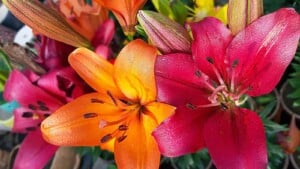It’s been pointed out by astute commenters and concerned blog readers that the term “hybrid seed” can mean more than we might intend it to. “Hybird” and the verb “hybridize” can mean both natural and man-assisted processes that combine traits of two genetically different plants. But “hybrid” is mostly used specifically as seeds and plants that are the result of first generation cross-breeding raised for commercial purposes. To avoid confusion in the future, your detail-oriented and anxious-to-please Planet Natural Blogger promises to identify those hybrids as commercial or F1 hybrids.
A hybrid plant results from a genetic cross. Hybridization can occur naturally when wind or bees or other insects carry pollen from one plant to another resulting in plants that can best survive in the particular environmental conditions where they exist. In this sense, all plants are hybrids, having evolved genetically over centuries to obtain their particular characteristics.
When gardeners talk about hybrids, they usually mean F1 hybrids, plants grown from seeds that are cross -pollinated with help from humans. As Janisse Ray explains it in her book The Seed Underground, “Hybridization is simply plant breeding sped up. The pollen from one plant with desirable characteristics is rubbed on the stigma of another plant with desirable characteristics. This flower produces a seed that, when grown, exhibits a combination of desirable characteristics…”

FREE SHIPPING!
Garden Seeds
All heirloom seeds offered by Planet Natural are non-treated and non-GMO.
View allPlanet Natural offers heirloom garden seeds — not the sort you’ll find in box stores — that are non-treated, non-GMO and NOT purchased from Monsanto-owned Seminis. Planting instructions are included with each packet and shipping is FREE!
The history of this process is fascinating. Farmers had long facilitated random selection of traits from fruits and vegetables to obtain desired qualities. In 1865, Gregor Mendel, presented his groundbreaking paper “Experiments In Plant Hybridization” that summarized his observations of this process in pea plants. Mendel discovered dominant and recessive genes and how they could be shared. Considered the father of genetics, Mendel laid the groundwork for the kind of plant breeding we know today (and eventually genetic engineering, another matter altogether). But plant breeding (hybridizing) didn’t take off until the process of growing corn with “hybrid vigor” became common place around 1930. Controlling the pollination of corn became big business — how many of us Midwesterners or our parents were employed briefly each summer as corn detasselers to prevent pollination (and therefore unwanted traits) from field corn?
Generating hybrids for the home gardener can be traced back to the end of World War II and the rise of gardening as business in America. Tomatoes are the best known hybrids. When Burpee introduced its Big Boy Hybrid in 1949 it was just the start of an avalanche of tomato types, bred exclusively for home gardeners. They carried traits like early maturity, juiciness, size, compact, bush-type plants, and various acid-sweetness balances (flavor). Tomatoes with traits preferred by commercial growers — such as ship-ability and storage traits — were also developed, sometimes at the expense of flavor.
Today, seed companies introduce new hybrids every year. Some become favorites while others fall into obscurity. But they all have one thing in common. They are F1 hybrids, indicating that they are the first generation of their particular hybrid. If you save their seeds and grow them next season, you will not get plants that are the same — or true — to the F1 hybrid. These second generation, F2 hybrids will have a small percentage of true plants, but the majority will be something different and probably not desirable. When you buy a Big Boy Hybrid, you know that it’s been cross-pollinated from specific parent plants; in other words, it’s F1. Finding and collecting true seed from F1 offspring, a difficult and tedious process, and then from F2 and F3 and so on, will eventually — usually over seven generations — breed a plant with the desired traits that produces seed that is 95% true. Seed producers find it easier just to produce a new crop of the F1 hybrid every year.

Hybrids grown this way aren’t evil, though some problems do result. Seed producers can patent the parents and process of their hybridization and thus “own” the seed, something that upsets the more community minded (see the chapter “Hooking Up” on plant breeder Will Bonsall in The Seed Underground). Of course, genetically engineered seeds or GMOs are a different thing entirely, created not by pollination but by manufactured genetic manipulation. Heirloom seeds — the word “heirloom” is interpreted different ways by different folks — are plants that give seeds that produce true. To be heirloom, the plant must have been around as is for at least 50 years, others say 100 years. As I see it, if it was available to my grandparents (for you younger folks, that might mean great-grandparents), it qualifies.
So what then are hybrids? While the term is casually thrown around (your friendly and apologetic Planet Natural Blogger pleads guilty), hybrid most often means commercially produced, F1 hybrids, as represented by the Big Boy Hybrid Tomato, among thousands of others. Yes, farmers for generations have created hybrids by cross-pollinating plants with different genetic traits. And there’s a naturally-occurring, on-going sort of hybridization, too. So, to avoid confusion, we’ll label the hybrids we most commonly refer to as “commercially-produced” or “F1.” In the meantime, thanks to all those who pointed out our unintended obfuscation.











